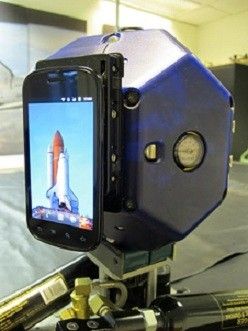Space Station Robots Get Nexus S Smartphones [VIDEO]

MIT grads supported by the U.S. Department of Defense and NASA have created a series of robot drones equipped with Samsung's Android powered Nexus S smartphone.
Officially designated Synchronized Position Hold, Engage, Reorient, Experimental Satellites (SPHERES), the machines are designed to explore how robots can help humans experiment and live in space more efficiently.
The SPHERES were first built after MIT professor David Miller challenged a number of his students to recreate the floating droid remote used by Luke Skywalker in the first "Star Wars" movie. Three of the SPHERES were picked up by NASA and have been on the International Space Station since 2006.
The Nexus S handsets where only added to the SPHERES after being upgraded for use in space. The upgrade saw Miller's team add an "expansion port" to each SPHERE, allowing extra "sensors and appendages, such as cameras and wireless power transfer systems" to be added.
The smartphones reportedly help the SPHERES perform maintenance tasks previously done by astronauts. These include jobs like recording sensor data and capturing video footage. NASA has since confirmed that in the future, the Nexus S handsets will be used to control and maneuver the SPHERES.
NASA reported that since arriving on the space station in 2006, astronauts have already conducted more than 25 experiments using the SPHERES. The tests run included checking techniques to advance the SPHERES' ability to enact automated dockings, satellite servicing, spacecraft assembly and emergency repairs.
If the experiments bear fruit, NASA reported plans to have the SPHERES take over even more tasks from the astronauts, freeing up their human co-workers time for more important duties.
"Mission control can remotely operate the smartphone-enhanced SPHERES to perform inventory and environmental surveys on the ISS," said Terry Fong, director of the Intelligent Robotics Group at NASA's Ames Research Center. "That way, astronauts can spend more time performing science experiments and other work, instead of routine maintenance. In the long run, free-flying robots like SPHERES could also be used to inspect the exterior of the space station or future deep-space vehicles."
© Copyright IBTimes 2024. All rights reserved.






